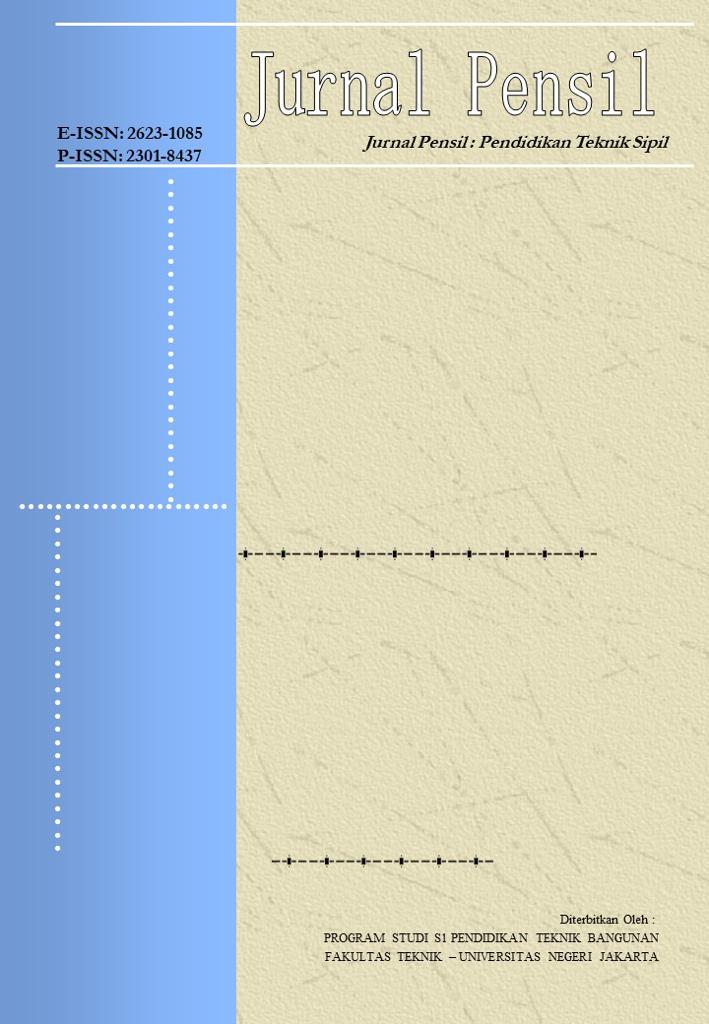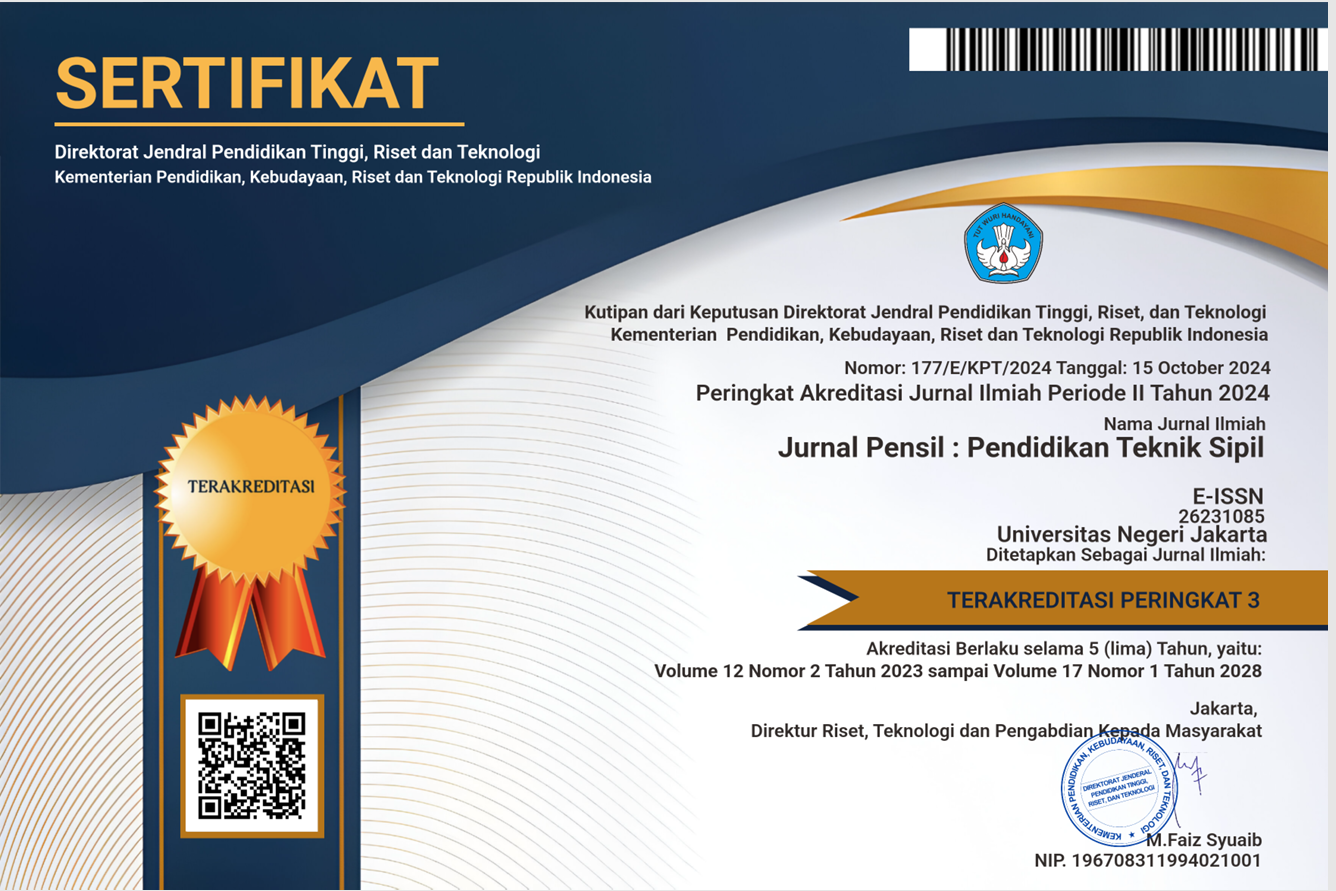BESTMITTEL AND SILICA FUME EFFECT ON CONCRETE COMPRESSIVE STRENGTH WITH SEAWATER CURING
DOI:
https://doi.org/10.21009/jpensil.v13i1.39103Keywords:
Bestmittel, Silica Fume, Seawater Curing, Compressive StrengthAbstract
The frequency of tidal floods caused by seawater threatens coastal buildings. This study aims to see how using seawater for concrete treatment affects the resulting compressive strength. This study used additives such as Bestmittel to expedite hardening and boost compressive strength, as well as silica fume to increase porosity and prevent concrete from becoming porous owing to chloride ion intrusion from seawater. The findings of concrete compressive strength tests were achieved through laboratory testing using cylindrical test objects measuring 150 mm in diameter and 300 mm in height. The test specimens were ordinary concrete with 0.6% bestmittel and a Silica Fume combination with varying percentages of 15%, 20%, and 25% substituting partial cement. Meanwhile, the concrete treatment employs both fresh water and seawater. Pressure tests were performed at 14 and 28 days. At 14 days, concrete with fresh water treatment and a bestmittel content of 0.6% and silica fume concentrations of 15%, 20%, and 25% have compressive strengths of 25.53 MPa, 27.11 MPa, and 26.04 MPa, respectively. Meanwhile, it was 26.34 MPa, 27.61 MPa, and 26.75 MPa after 28 days of concrete age. At 14 consecutive days of concrete age, concrete with seawater treatment had a reduced compressive strength. 19.66 MPa, 22.13 MPa, and 23.07 MPa, respectively. Meanwhile, at 28 days, the pressures were 20.53 MPa, 24.77 MPa, and 25.53 MPa. Using 6% bestmittel followed by 15-20% SF can boost the strength of the concrete and let it survive reduced compressive strength due to seawater infiltration.
References
Akomah, B. B., & Jackson, E. N. (2018). The Influence of pH on The Compressive Strength of Concrete. 5(9).
Al Jaaf, H. J. M., Ali, M. A. A. W., & Al-Jadiri, R. S. (2019). Effect of pH Solutions on Using Waste Marble powder to Enhance Mortar Compressive Strength. In IOP Conference Series: Materials Science and Engineering (Vol. 561, No. 1, p. 012130). IOP Publishing.
Anitha, J., Pradeepa, S., Soni, L., & Rakshit, K. B. (2016). Influence of admixtures on behavior of concrete. International Journal of Research in Advent Technology, 4(11), 16-23.
ASTM C494-81. (2004). Standart Specification For Chemical Admixture For Concrete. ASTM International, West Conshohocken, PA, Doi: 10.1520/C0494_C0494M-81.
ASTM C494. (2017). Standard and Specification for Chemical Admixtures for Concrete,. ASTM International, West Conshohocken, PA, 2017. Doi: 10.1520/C0494_C0494M-17.
ASTM C618. (2023). Standard Specification for Coal Ash and Raw or Calcined Natural Pozzolan for Use in Concrete. In Edition, March 1, 2023.
Badan Standardisasi Nasional. (2002). Tata Cara Perhitungan Struktur Beton Untuk Bangunan Gedung. SNI 03-2847-2002. Bandung: Badan Standardisasi Nasional, 251.
Diawarman, D. (2017). Analisa Pengaruh Kuat Tekan Beton K. 250 Dengan Menggunakan Air Asin (Air Laut) + Kapur Gamping Dan Air Tawar. Jurnal Teknik Sipil, 7(1), 18-26.
Erniati, Tjaronge, M. W., Zulharnah, & Irfan, U. R. (2015). Porosity, pore size and compressive strength of self compacting concrete using sea water. Procedia Engineering, 125, 832–837. https://doi.org/10.1016/j.proeng.2015.11.045
Fahirah, F. (2007). Korosi pada Beton Bertulang dan Pencegahannya. SMARTek, 5(3), 190–195.
Fattouh, M., & Elsayed, E. (2023). Influence of Utilizing Glass Powder with Silica Fume on Mechanical Properties and Microstructure of Concrete. Delta University Scientific Journal, 6(1), 111–122. https://doi.org/10.21608/dusj.2023.291027
Furuya, D., Otsuki, N., Saito, T., & Yun, L. (2009). A Study On The Effects Of Seawater as Mixing Water on The Hydration Characteristics of Blast-Furnace Slag Cement. 4thConference on Our World In Concrete & Structure: 16 - 18 August 2009, Singapore.
Haris, S., & Firdaus, R. (2021). Pengaruh Penggunaan Silica Fume Powder Terhadap Kuat Tekan Beton. Jurnal Online Sekolah Tinggi …, 16(1), 97–103.
Hulu, J. C. D., Hutabarat, L. E., & Simanjuntak, R. (2023). Utilization of Waste Ceramic Powder as a Substitute of Fine. Toward Adaptive Research and Technology Development for Future Life AIP Conf. Proc. 2689, 040006-1–040006-8; Https://Doi.Org/10.1063/5.0114932 Published by AIP Publishing. 978-0-7354-4470-6/$30.00.
Laia, Y., Hutabarat, L. E., & Tampubolon, S. P. (2023). Compressive Strength Characteristic of Fly Ash Light. Toward Adaptive Research and Technology Development for Future Life AIP Conf. Proc. 2689, 040006-1–040006-8; Https://Doi.Org/10.1063/5.0114932 Published by AIP Publishing. 978-0-7354-4470-6/$30.00, 040006.
Liu, H., Luo, G., Wang, L., Wang, W., Li, W., & Gong, Y. (2018). Laboratory evaluation of eco-friendly pervious concrete pavement material containing silica fume. Applied Sciences (Switzerland), 9(1). https://doi.org/10.3390/app9010073
Meng, X. H., & Zhang, S. Y. (2016). Application and development of stainless steel reinforced concrete structure. MATEC Web of Conferences, 63, 03009. https://doi.org/10.1051/matecconf/20166303009
Olutoge, F. Adeyemi, Amusan, G. M. (2014). The Effect of Sea Water on Compressive Strength of Concrete. International Journal of Engineering Science Invention ISSN (Online): 2319 – 6734, ISSN (Print): 2319 – 6726 Www.Ijesi.Org, 3(7), 23–31.
Pan, C., Li, X., & Mao, J. (2020). The Effect of a corrosion inhibitor on the rehabilitation of reinforced concrete containing sea sand and seawater. Materials, 13(6). https://doi.org/10.3390/ma13061480
Prasittisopin, L., & Trejo, D. (2015). Hydration and phase formation of blended cementitious systems incorporating chemically transformed rice husk ash. Cement and Concrete Composites, 59, 100–106. https://doi.org/10.1016/j.cemconcomp.2015.03.002
Samosir, F., Hutabarat, L. E., Purnomo, C. C., & Tampubolon, S. P. (2021). The Effect of Bagasse Fibers Martial Substitution of Coarse Aggregate to Increase Compressive Strength and Tensile Strength on Lightweight Concrete. IOP Conference Series: Earth and Environmental Science, 878(1). https://doi.org/10.1088/1755-1315/878/1/012046
Siregar, R. A., Hutabarat, L. E., Tampubolon, S. P., & Purnomo, C. C. (2021). Optimizing Empty Fruit Bunch (EFB) of Palm and Glass Powder as A Partial Substitution Material of Fine Aggregate to Increase Compressive and Tensile Strength of Normal Concrete. IOP Conference Series: Earth and Environmental Science, 878(1). https://doi.org/10.1088/1755-1315/878/1/012047
SNI 03-2847. (2002). Tata Cara Penghitungan Struktur Beton Untuk Bangunan Gedung. In Komite Standardisasi Konstruksi dan Bangunan Gedung, Bandung.
SNI 1974. (2011). Cara Uji Kuat Tekan Beton dengan Benda Uji Slinder. Badan Standar Nasional [BSN], Jakarta.
SNI 2493. (2011). Tata Cara Pembuatan dan Perawatan Benda Uji Beton di Laboratorium. Badan Standar Nasional [BSN], Jakarta.
SNI 7656. (2012). Tata Cara Pemilihan Campuran untuk Beton Normal, Beton Berat dan Beton Massa. In Badan Standarisasi Nasional,.
SNI 7974. (2013). Sepesifikasi Air Pencampuran yang Digunakan Dalam Produksi Beton Semen Hidraulis. (ASTM C1602-06, IDT). Badan Standar Nasional (BSN), Jakarta.
SNI S-18-1990-03. (1990). Spesiflkasi Bahan Tambahan untuk Beton. Departemen Pekerjaan Umum, Yayasan Badan Penerbit Pekerjaan Umum, Jakarta.
Sulistyawati, R. (2009). Pengaruh Penggunaan Zat Additive Bestmittel Terhadap Kuat Tekan Beton. Jurnal Teodolita, 11(2), 34–46.
Sutriono, B., Trimurtiningrum, R., & Rizkiardi, A. (2018). Pengaruh Silica Fume sebagai Subtitusi Semen terhadap Nilai Resapan dan Kuat Tekan Mortar. RekaRacana: Jurnal Teknik Sipil, 4(4), 12–21. https://doi.org/10.26760/rekaracana.v4i4.12
Tan, Y., Yu, H., & Wu, C. (2020). Investigation on the corrosion behavior of steel embedded in basic magnesium sulfate cement concrete: An attempt and challenges. ACS Omega, 5(43), 27846–27856. https://doi.org/10.1021/acsomega.0c02882
Thiago J. Mesquita, Chauveau, E., Mantel, M., Kinsman, N., & Nogueira, R. P. (2013). Influence of Mo Alloying on Pitting Corrosion of Stainless Steels Used as Concrete Reinforcement. REM: R. Esc. Minas, Ouro Preto, 66(2), 173–178.
Thomas, B. S. (2018). Green concrete partially comprised of rice husk ash as a supplementary cementitious material – A comprehensive review. Renewable and Sustainable Energy Reviews, 82(March 2017), 3913–3923. https://doi.org/10.1016/j.rser.2017.10.081
Uzbas, B., & Aydin, A. C. (2020). Microstructural Analysis of Silica Fume Concrete with Scanning Electron Microscopy and X-Ray Diffraction. Engineering, Technology & Applied Science Research, 10(3), 5845–5850. https://doi.org/10.48084/etasr.3288
Wang, G., Wu, Q., Li, X. Z., Xu, J., Xu, Y., Shi, W. H., & Wang, S. L. (2019). Microscopic analysis of steel corrosion products in seawater and sea-sand concrete. Materials, 12(20), 1–12. https://doi.org/10.3390/ma12203330
Wegian, F. M. (2010). Effect of seawater for mixing and curing on structural concrete. Department of Civil Engineering, College of Technological Studies (PAAET), 42325 Shuwaikh, 70654 Kuwait.
Yang, L., Yilmaz, E., Li, J., Liu, H., & Jiang, H. (2018). Effect of superplasticizer type and dosage on fluidity and strength behavior of cemented tailings backfill with different solid contents. Construction and Building Materials, 187, 290–298. https://doi.org/10.1016/j.conbuildmat.2018.07.155
Yu, K., Li, L., Yu, J., Xiao, J., Ye, J., & Wang, Y. (2018). Feasibility of using ultra-high ductility cementitious composites for concrete structures without steel rebar. Engineering Structures, 170(May), 11–20. https://doi.org/10.1016/j.engstruct.2018.05.037
Zhang, P., & Li, Q. F. (2013). Effect of silica fume on durability of concrete composites containing fly ash. Science and Engineering of Composite Materials, 20(1), 57–65. https://doi.org/10.1515/secm-2012-0081
Zhu, F., Ma, Z., & Zhao, T. (2016). Influence of Freeze-Thaw Damage on the Steel Corrosion and Bond-Slip Behavior in the Reinforced Concrete. Advances in Materials Science and Engineering, 2016. https://doi.org/10.1155/2016/9710678











.png)
.png)
1.png)

